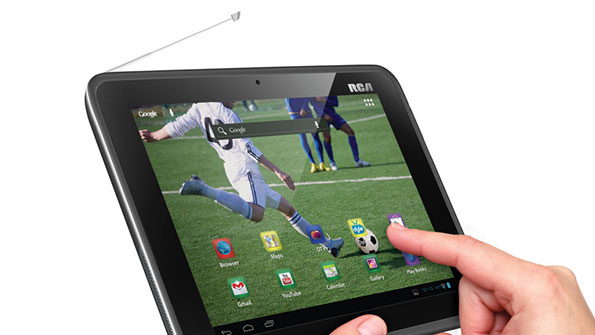Can the RCA Mobile TV Dyle Tablet Beat the Apple iPad?

Dyle is a multi-company consortium that is centered around focused branding; the name on any product means that it is ready to pick up OTA broadcasts. Development has been slow, but at CES 2013 RCA debuted a new device that may change some people’s minds about mobile TV. The tough part of the battle, however, is to steer viewers away from using the iPad they already own.
With RCA's new device, echoes of the Sony Watchman (remember?) can still be felt, but with a more modern twist. The 8in tablet weighs about a pound and a half (almost exactly the same weight as a current full-size iPad with Retina display) and sports a 1GHz Telechip Cortex-A5-based processor, 8GB of memory, 1GB of RAM, built-in GPS, dual cameras, MicroUSB, MicroSD and an HDMI port. The resolution is a respectable 1024 x 768, not bad, but not great. The battery lasts for 4 hours watching TV or 10 hours using the OS. The OS is Android, and you can do all the usual things including web browsing, apps and purchasing from the Google Play store. One compelling feature is the fact that the unit has a dual tuner.
The RCA Mobile TV can accept OTA ATSC broadcasts, and can use the Dyle mobile TV service, which works via a separate Android app. The unit allows watching more than 130 stations nationwide in 35 U.S. markets. The unit has an extending antenna for picking up TV signals and the price will set you back $299. The tablet is expected to ship in April.
Tablets compared
With specs sorta close to the Apple iPad, it’s interesting to compare the two to see how each measures up. Without the Apple iOS but running the serviceable Android 4.0.4, consumers will still be able to do a lot of “tablet stuff” when they are not watching TV. But there may be several stumbling blocks. People used to the iPad Retina display or other higher-resolution tablets may yearn for more pixels. It’s also surprising with the advanced antenna technology we have currently (such as the iPhone 5’s buil- in antenna) that products, and specifically Dyle products, still slap on a circa 1950 extending TV antenna. Not only does this “feature” immediately root any new device firmly in the past, it also puts up an (extending) flag to signify that not a lot of future-forward technology went into grabbing the broadcast TV signals. Also before I forget, did I mention there is no DVR features? If you want to watch a live show, that is the only way to watch it, live.
Having Android on board is certainly more appealing than just having a TV, but with pedestrian specs and a $300 price point, it could be a tough sell. RCA will need to really decide who the market for this device is. They are slamming up against a world where the iPad with multiple streaming and on-demand apps offer millions of hours of programming. Sure you could download apps on this Android tablet to do much of the same, but then you are slipping off the grid of the original intent, which is to pick up local HD television stations for free.
The Sony Watchman was a portable TV and current Dyle products are not straying too far from that dated concept. The RCA unit and others this year may have to reinvent the whole concept of a portable TV for it to trigger a reaction from consumers. Losing the gawky antenna is a no brainer, but there needs to be a compelling feature or two to sway people away from an Apple iPad purchase. An amazing new interface, ultra thin, voice-controlled, simulated surround sound, effortless DVR functionality, there are many directions manufacturers could/should head. Unfortunately ordinary bulky tablets running basic software and including old TV antennas seems to be par for the course.
The professional video industry's #1 source for news, trends and product and tech information. Sign up below.
We’ll find out how RCA fairs in April when the unit starts shipping. One saving grace on its side is content cost. Subscribing to streaming services and purchasing movies and TV shows can get pricey. RCA is offering a device with free 24/7 entertainment. There are several demographics that would be keenly interested in this concept. But the product has to be ultra compelling, and get consumers to put down the tablet that is already in their hand.
